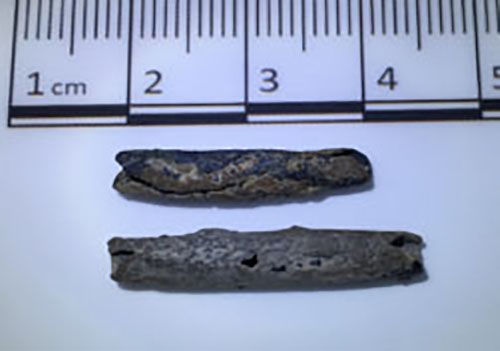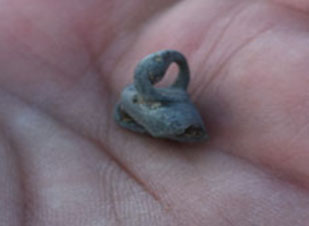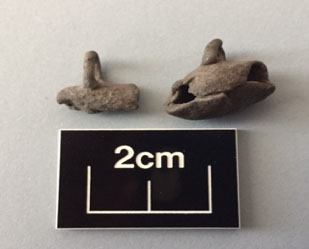Maxwell Museum Blog

Discovery of Prehistoric Copper Artifacts in Southern Tularosa Basin of New Mexico
Christopher Adams District Archaeologist, Gila National Forest
Alexander Kurota Senior Archeologist, Office of Contract Archeology
The Office of Contract Archeology (OCA) fieldwork on White Sands Missile Range (WSMR) has resulted in the discovery of rare prehistoric artifacts made of copper. This archaeological success story is a result of the cooperation with the Gila National Forest archaeologist Chris Adams and OCA archaeologists working on WSMR.
The archaeological team visited three of the major El Paso Phase Jornada Mogollon adobe roomblock sites on WSMR. Using the latest metal scanning technology, Adams and his colleague Charlie Haecker discovered five native copper nuggets, three copper beads, and one copper bell. Adams’ on-going work in the Mimbres Valley of western New Mexico has shed light on the fact that the Mimbres where exploiting native copper nuggets from the Santa Rita Mine area during AD 950-A.D. 1130.
All three beads appear to have been made using the cold-hammer technique, made of raw pieces of copper hammered into thin sheets then rolled into burrito-like forms called beads (Figure 1). The prehistoric copper beads are extremely rare in the American Southwest with the only comparative specimens being recovered in 1919 by archaeologist Earl Morris from the Aztec Ruin in northwestern New Mexico. Almost 100 years later, three more beads are now known to have come from the two of the El Paso phase village sites.
What is unique about this copper bell is that the bell/body was altered. No clapper stone was evident, but it appears to have been folded, reshaped and/or crushed. Adams has already found several examples of this type of altered copper bell in the Mimbres area. Is this a form of ritual retirement, because the function of the copper bell has been changed? The altered copper bells examples from the Mimbres Valley have been found in large open areas adjacent to the pueblo roomblocks. Similarly the beads and the bell from WSMR were also found close to the plazas and other open areas possibly used for communal gathering.
An alternative explanation for the altered bells suggests that, after a portion of the bell broke off, the object may have been reshaped into a bead-like form to be still capable of producing a ringing sound. Copper artifacts likely would have been considered to be indicators of economic and social status among the prehistoric groups. This would explain the possible reshaping of the valuable copper objects of adornment. Perhaps it is also not surprising that the copper bells and the beads have been discovered in the plaza areas where prehistoric dancers may have worn such items during communal gathering and some of the beads and bells could have been lost during such events.


Photograph of the altered copper bell from LA 117502 taken upon its discovery in the field.
Two examples of altered copper bells from the Gila National Forest.

